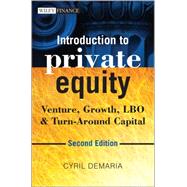This second edition of Introduction to Private Equity is more than an update, it reflects the dramatic changes which have affected an industry which is evolving rapidly, internationalizing and maturing fast. What is recognized as a critical yet grounded guide to the private equity industry blends academic rigour with practical experience. It provides a clear, synthetic and critical perspective of the industry from a professional who has worked at many levels within the industry; including insurance, funds of funds, funds and portfolio companies.
The book approaches the private equity sector top-down, to provide a sense of its evolution and how the current situation has been built. It then details the interrelations between investors, funds, fund managers and entrepreneurs. At this point, the perspective shifts to bottom-up, how a private business is valued, how transactions are processed and the due diligence issues to consider before moving ahead.
Introduction to Private Equity, Second Edition covers the private equity industry as a whole, putting its recent developments (such as secondary markets, crowdfunding, venture capital in emerging markets) into perspective. The book covers its organization, governance and function, then details the various segments within the industry, including Leveraged Buy-Outs, Venture Capital, Mezzanine Financing, Growth Capital, Distressed Debt, Turn-Around Capital, Funds of Funds and beyond. Finally, it offers a framework to anticipate and understand its future developments.
This book provides a balanced perspective on the corporate governance challenges affecting the industry and draws perspectives on the evolution of the sector, following a major crisis.








